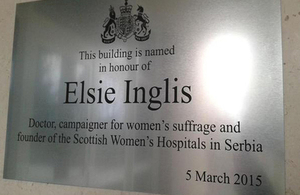British Residence in Belgrade named after Elsie Inglis
On the occasion of the WW1 Centenary and the International Women’s Day, Ambassador Keefe named the Residence in Belgrade “Elsie Inglis House”.

Her Majesty’s Ambassador Denis Keefe and the President of the Republic of Serbia, Tomislav Nikolic revealed a plaque at the entrance into the Residence.

Dr Elsie Inglis was a British doctor, member of the suffragist movement and humanitarian worker, who participated in the foundation of the “Scottish Women’s Hospitals”. During World War One, she was active in helping Serbian army in hospitals in Kragujevac, Mladenovac, Lazarevac, Kruševac, Valjevo, but also Thessaloniki, Corsica, Odessa. She died in November 1917, immediately upon her return to Britain from German captivity.
Guests at the reception on the occasion were representatives of institutions, municipalities and organisations with whom the Embassy cooperated during Centenary commemorative events.

Before unveiling the plaque, Ambassador Keefe emphasised that Elsie Inglis was one of more than six hundred British women who came to Serbia as part of the Allied medical missions.
Ambassador Keefe concluded:
Elsie Inglis was one of the first women in Scotland who had finished high education and was a pioneer of medicine. She fought energetically against prejudice, for social and political emancipation of women in Britain. She was also a tireless volunteer, courageous organiser of the Scotish Women’s Hospitals and a dedicated humanitarian. Unfortunately Elsie Inglis didn’t live long enough to see the triumph of some of her ideas, but she has had a tremendous influence on social trends in our country. In Scotland she became a doctor, in Serbia she became a saint.
More images from the event at the UKinSerbia Flickr page.